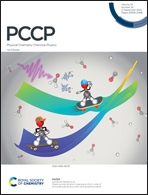Lanthanide/actinide boride nanoclusters and nanomaterials based on boron frameworks consisting of conjoined Bn rings (n = 7–9)†
Abstract
Extensive global minimum searches augmented with first-principles theory calculations performed in this work indicate that the experimentally observed perfect inverse sandwich lanthanide boride complexes D7h La2B7− (1), D8h La2B8 (3), D9h La2B9− (7) can be extended to their actinide counterparts C2v Ac2B7− (1′), D8h Ac2B8 (3′), D9h Ac2B9− (7′) with a Bn monocyclic ring (n = 7–9) sandwiched by two Ac dopants. Such M2Bn−/0 inverse sandwiches (1/1′, 3/3′, 7/7′) can be used as building blocks to generate the ground-state C2 La4B13− (2)/Ac4B13− (2′), D2 La4B15− (4)/Ac4B15− (4′), C3v/C3 La4B18 (5)/Ac4B18 (5′), Oh Ac7B24+ (6′), Oh Ac7B24, Td Ac4B24 (8′), C1 La5B24+ (9)/Ac5B24+ (9′), and Td Ac4B29− (10′) which are based on boron frameworks consisting of multiple conjoined Bn rings (n = 7–9). Detailed bonding analyses show that effective (d–p)σ, (d–p)π and (d–p)δ coordination bonds are formed between the Bn rings and metal doping centers, conferring three-dimensional aromaticity and extra stability to the systems. In particular, the perfect body-centered cubic Oh Ac7B24+ (6′) and Oh Ac7B24 with six conjoined B8 rings can be extended in x, y, and z dimensions to form one-dimensional Ac10B32 (11′), two-dimensional Ac3B10 (12′), and three-dimensional AcB6 (13′) nanomaterials, presenting a B8-based bottom-up approach from metal boride nanoclusters to their low-dimensional nanomaterials.



 Please wait while we load your content...
Please wait while we load your content...